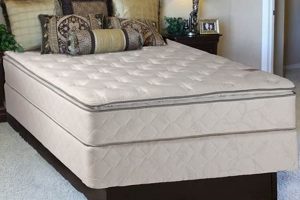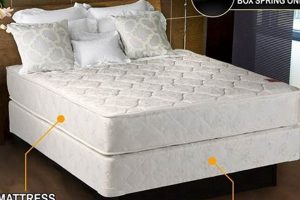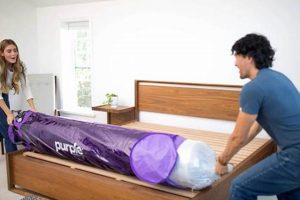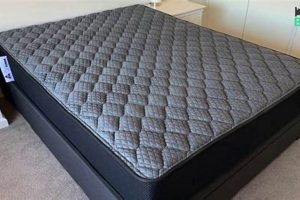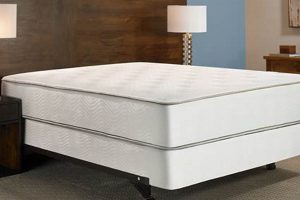The necessity of a supportive foundation for a mattress is a common inquiry among consumers. This consideration directly impacts mattress longevity, comfort, and warranty validity. The foundational support system provides crucial elevation and shock absorption, influencing sleep quality and the overall lifespan of the sleep product.
Proper support offers several benefits. It can prevent premature sagging and maintain structural integrity, thereby extending the life of the mattress. Adequate elevation facilitates airflow, minimizing moisture buildup and potential mold growth. Historically, bed frames were rudimentary structures; however, advancements in sleep technology have led to diverse support systems designed to complement different mattress types.
The following sections will delve into the various types of mattress support systems, examining their compatibility with different mattress types and exploring factors to consider when choosing the appropriate foundation for optimal sleep and mattress performance.
Guidance on Mattress Foundation Requirements
Selecting the correct foundation for a mattress is critical for ensuring both comfort and longevity. The following recommendations provide essential guidance for navigating the complexities of mattress support systems.
Tip 1: Review the Mattress Warranty: Consult the manufacturer’s warranty for specific foundation requirements. Failure to adhere to these guidelines may void the warranty in case of premature mattress degradation.
Tip 2: Consider Mattress Type: Innerspring mattresses often benefit from a traditional box spring to provide optimal support and prevent sagging. Memory foam and latex mattresses may perform better on a solid platform or adjustable base.
Tip 3: Evaluate Bed Frame Compatibility: Ensure the chosen support system is compatible with the existing bed frame. Some bed frames require specific types of foundations for proper fit and stability.
Tip 4: Assess Weight Distribution: Individuals with higher body weight may require a sturdier foundation to prevent premature wear and maintain mattress integrity. Reinforced slats or a solid platform can provide additional support.
Tip 5: Prioritize Proper Airflow: Certain mattress types, particularly those with foam layers, require adequate airflow to prevent moisture buildup. Slatted foundations or breathable materials can promote ventilation.
Tip 6: Account for Height Preferences: The height of the foundation will affect the overall height of the bed. Consider personal preferences and mobility limitations when selecting a foundation.
The correct choice of mattress foundation is an investment in sleep quality and mattress longevity. Adhering to these guidelines ensures optimal support and prevents potential issues arising from incompatible support systems.
The subsequent sections will address specific scenarios and explore alternative solutions for various mattress and lifestyle needs.
1. Mattress type
The type of mattress directly influences the necessity of a box spring. Different mattress constructions require varying levels and types of support. Innerspring mattresses, characterized by their coil systems, often benefit from the shock absorption and even support provided by a box spring. Without adequate support, the coils can prematurely degrade, leading to sagging and reduced comfort. Conversely, memory foam and latex mattresses, often designed with a solid core, may not require the spring action of a traditional box spring. A solid platform or slatted foundation can provide sufficient support without the added bounce.
Furthermore, hybrid mattresses, combining elements of both innerspring and foam technologies, present a unique scenario. The innerspring component typically necessitates robust support to prevent coil breakdown, while the foam layers require a stable surface to maintain their shape and integrity. Many hybrid mattress warranties specify the use of a particular foundation type to ensure proper support and prevent voiding the warranty. A common example is a hybrid mattress paired with a platform bed featuring closely spaced slats, providing both support and adequate ventilation.
In summary, mattress type dictates the necessary support structure. The selection of a foundationwhether a box spring, platform, or slatted basemust align with the mattress’s construction to maximize its lifespan, maintain comfort, and adhere to warranty stipulations. The interaction between these elements is key to realizing the full potential of the sleep product.
2. Warranty requirements
Warranty requirements regarding mattress foundations represent a critical, often overlooked, aspect of mattress ownership. Mattress manufacturers establish specific foundation guidelines to ensure adequate support and protect against premature wear, thereby safeguarding their product’s performance and longevity.
- Foundation Type Specifications
Mattress warranties frequently dictate the acceptable types of foundations. These specifications may include requirements for solid platforms, specific slat spacing, or the use of a traditional box spring. Failure to comply with these stipulations can result in warranty voidance if the mattress exhibits sagging, indentations, or other support-related issues. For example, a memory foam mattress warranty might explicitly require a solid platform to prevent uneven weight distribution.
- Support System Dimensions and Materials
Warranties often specify minimum dimensions and material requirements for the foundation. For instance, a queen-size mattress warranty could stipulate that the foundation must provide continuous support across the entire sleeping surface and be constructed of durable materials capable of withstanding the mattress’s weight and intended use. Metal frames with inadequate center support, for example, may be deemed non-compliant, leading to claim denial.
- Consequences of Non-Compliance
The repercussions of disregarding warranty-stipulated foundation requirements can be significant. If a mattress fails due to inadequate support and the owner has not adhered to the foundation guidelines, the warranty claim may be denied. This leaves the consumer responsible for the cost of replacement or repair. Documentation, such as photographs of the foundation or proof of purchase, may be required to validate compliance with warranty terms.
- Foundation Age and Condition
Some warranties stipulate that the foundation used with the mattress must be new or in good condition. Using an old, damaged, or structurally unsound foundation can compromise mattress support and invalidate the warranty. Manufacturers may reserve the right to inspect the foundation’s condition and deny claims if it is deemed to be a contributing factor to the mattress’s failure.
In conclusion, adherence to warranty requirements concerning mattress foundations is essential to protect the consumer’s investment and ensure the mattress performs as intended. Carefully reviewing the warranty documentation and selecting a compliant foundation is a prudent step in maximizing the lifespan and support of the sleep product.
3. Bed frame compatibility
The compatibility between a bed frame and a mattress support system directly influences the decision regarding the necessity of a box spring. The bed frame’s design and construction dictate the type of support required to ensure proper mattress function and longevity. Understanding this relationship is crucial in determining if a box spring is indeed needed.
- Platform Bed Frames
Platform bed frames, characterized by their solid or closely-slatted surfaces, often eliminate the need for a box spring. The integrated support system provides a stable foundation for the mattress, distributing weight evenly. In this scenario, adding a box spring could elevate the mattress to an undesirable height and compromise the intended aesthetic. Conversely, using a box spring on a platform bed may void the mattress warranty if it alters the designed support structure.
- Metal Bed Frames with Slats
Metal bed frames with widely spaced slats typically necessitate a box spring. The gaps between the slats lack sufficient support for the mattress, potentially leading to sagging and uneven wear. A box spring provides a continuous, supportive surface, preventing the mattress from deforming and extending its lifespan. In this instance, a box spring acts as a crucial intermediary between the frame and the mattress, ensuring proper support and preserving mattress integrity.
- Bed Frames with Headboards and Footboards
Bed frames consisting solely of a headboard and footboard, with minimal or no side rails, invariably require a separate support system. In these cases, a box spring is essential for providing a level surface and preventing the mattress from sliding or falling through the frame. The box spring serves as the primary support structure, distributing weight evenly and maintaining the mattress’s position within the bed frame.
- Adjustable Bed Frames
Adjustable bed frames, designed to articulate into various positions, generally do not require a traditional box spring. These frames incorporate integrated support systems engineered to accommodate the mattress’s movements. Using a standard box spring with an adjustable frame can impede its functionality and potentially damage the mattress or the frame itself. Instead, mattresses designed specifically for adjustable beds are placed directly onto the frame’s surface.
The relationship between bed frame design and the need for a box spring underscores the importance of considering the existing support structure. When selecting a new mattress, evaluating the current bed frame is paramount in determining whether a box spring is necessary to achieve optimal support, comfort, and mattress longevity.
4. Support requirements
Mattress support requirements are directly linked to the decision of whether a box spring is necessary. The fundamental function of a mattress foundation, including a box spring, is to provide adequate support to the mattress, ensuring proper weight distribution and preventing premature sagging. Without sufficient support, the mattress’s lifespan is compromised, and the user experiences reduced comfort and potential musculoskeletal issues.
The type of mattress significantly influences its support needs. For example, an innerspring mattress, characterized by its network of coils, typically necessitates a box spring to absorb shock and distribute weight evenly across the sleeping surface. This prevents localized pressure points that can lead to coil breakdown and mattress deformation. In contrast, a memory foam mattress, designed with a dense, supportive core, may function optimally on a solid platform, negating the need for a box spring. Failing to meet the mattress’s support requirements, regardless of its type, can void the manufacturer’s warranty, highlighting the practical significance of understanding these specifications.
Ultimately, assessing a mattress’s support needs is paramount in determining the suitability of a box spring. The decision should be based on a combination of mattress type, manufacturer recommendations, and individual comfort preferences. Adhering to these guidelines ensures optimal sleep quality and maximizes the investment in the sleep product, while addressing potential challenges associated with inadequate support or incompatible foundation choices.
5. Airflow considerations
Airflow considerations play a critical role in determining the necessity of a box spring for a mattress. Adequate ventilation beneath a mattress is essential for preventing moisture accumulation, which can lead to mold growth, dust mite proliferation, and material degradation. The design of the foundation significantly impacts airflow and, consequently, the longevity and hygiene of the sleep surface.
Box springs, particularly those with open coil designs, often promote airflow compared to solid platform foundations. The open structure allows for increased circulation, reducing the risk of moisture buildup within the mattress. This is particularly important for mattresses constructed with dense materials, such as memory foam, which can restrict airflow and trap humidity. However, the effectiveness of a box spring in promoting airflow depends on its specific design and the surrounding environment. A box spring placed directly on the floor, for instance, may not provide adequate ventilation due to limited clearance.
In situations where airflow is a primary concern, alternative foundation options, such as slatted platforms, may offer a comparable or superior solution. Slatted foundations provide structural support while allowing air to circulate freely beneath the mattress. The spacing between the slats directly influences the level of ventilation. Ultimately, the decision regarding a box spring should consider the mattress type, the environment’s humidity level, and the foundation’s capacity to facilitate airflow, ensuring a hygienic and durable sleep surface.
6. Height preference
Height preference is a significant determinant in evaluating mattress support needs and, consequently, the necessity of a box spring. The desired bed height, often dictated by personal comfort, accessibility, or aesthetic considerations, directly influences the choice of foundation. A box spring, by adding vertical height, can transform a low-profile bed into one that aligns with individual preferences or medical requirements. For example, individuals with mobility limitations may require a higher bed for ease of entry and exit, a function that a box spring effectively addresses. In contrast, those seeking a minimalist aesthetic may prefer a lower bed, making a platform base a more suitable option.
The impact of height preference extends beyond mere convenience. It can influence posture and spinal alignment during sleep. An inappropriately low bed may necessitate excessive bending, potentially exacerbating back pain or discomfort. Conversely, an excessively high bed may require undue effort to climb into, especially for older adults. The correct bed height allows for a natural transition from standing to sitting and lying down, minimizing strain on the body. This ergonomic consideration underscores the importance of factoring height preference into the selection of a mattress support system.
In conclusion, height preference acts as a critical variable when assessing the need for a box spring. This factor intersects with personal comfort, accessibility needs, and ergonomic considerations. The optimal bed height provides both ease of use and support for proper spinal alignment. Ultimately, the choice of a box spring should integrate these factors to create a sleep environment tailored to individual needs and preferences, recognizing that there is no one-size-fits-all solution in mattress support.
Frequently Asked Questions
The following section addresses common inquiries regarding mattress foundations, providing succinct answers to prevalent concerns.
Question 1: Are box springs required for all mattresses?
The necessity of a box spring depends on the mattress type, bed frame configuration, and warranty specifications. Not all mattresses require a box spring for adequate support.
Question 2: Can any type of box spring be used with a new mattress?
No. The manufacturer’s warranty typically specifies acceptable foundation types. Utilizing a non-compliant foundation can void the warranty.
Question 3: What are the alternatives to a box spring?
Alternatives include platform beds, slatted foundations, and adjustable bed frames. The suitability of each depends on the mattress type and personal preference.
Question 4: How does a box spring affect mattress longevity?
A box spring can extend mattress lifespan by providing support and absorbing shock, preventing premature sagging and wear, provided it’s compatible with the mattress type.
Question 5: Is it necessary to replace the box spring when replacing the mattress?
The condition of the existing box spring should be evaluated. If the box spring is damaged or provides inadequate support, replacement is recommended.
Question 6: How does mattress weight influence the choice of foundation?
Heavier mattresses require a sturdier foundation. Reinforced slats or a solid platform may be necessary to provide adequate support and prevent sagging.
In summary, the decision to utilize a box spring or alternative foundation should be based on a thorough assessment of mattress type, warranty requirements, and personal preferences.
The subsequent section will address scenarios and explore alternative solutions for various mattress and lifestyle needs.
Assessing Mattress Foundation Needs
The exploration of whether a box spring is required for a mattress reveals a multifaceted decision-making process. Key considerations include mattress type, warranty stipulations, bed frame compatibility, support requirements, airflow needs, and height preferences. Understanding these elements enables an informed decision, optimizing mattress performance and longevity.
The appropriate mattress foundation represents a significant investment in sleep quality and mattress preservation. Prioritizing these factors can avoid potential warranty invalidations and ensure the prolonged comfort and support provided by the sleep system. Individuals are encouraged to review warranty documentation and consult with sleep professionals to determine the optimal foundation for their specific needs.


![Complete Twin Beds: Mattress & Box Spring Set [Deals] Organic & Natural Mattress Buyer’s Guide: Non-Toxic Sleep Solutions Complete Twin Beds: Mattress & Box Spring Set [Deals] | Organic & Natural Mattress Buyer’s Guide: Non-Toxic Sleep Solutions](https://mattressworldpa.com/wp-content/uploads/2025/07/th-3405-300x200.jpg)
